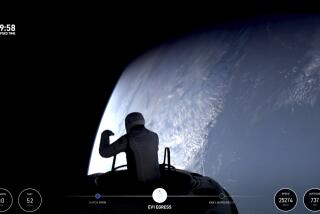Dressing Astronauts for Success in Space
WINDSOR LOCKS, Conn. â Like a giant 250-pound jigsaw puzzle, the U.S. spacesuit is assembled from components tailor-made for it by workers across the nation who do not see the final product except in images broadcast from space.
Eighty firms contribute to the $10.4-million suit, officially called an extravehicular mobility unit, making parts as tiny as a one-eighth-inch washer and as big as a 30-inch-long water tank.
The extravehicular mobility unit actually is used only when astronauts leave the shuttle for space walks and is not to be confused with the flight suit, the orange jumper that astronauts wear in the shuttle during missions.
Even the company that oversees the subcontractors and assembly of the suit, Hamilton Standard, does not see the pieces come together--that happens at NASA headquarters in Houston.
Most of the parts are made by small businesses.
âItâs interesting to go out and visit some of these people. You expect to see another Hamilton Standard, and theyâre not a Hamilton Standard,â said Bob Poisson, deputy program manager at Hamilton Standard, a unit of United Technologies Corp.
Instead of big, modern, high-tech plants, some are small businesses operating out of warehouses from New England to California.
Sustaining a supplier base is not easy, given the sporadic nature of the orders, Poisson said.
âWe donât stamp these things out like cars,â said Michael Gan, a contract manager at Hamilton Standard. âThe problem is having a sustained commitment from such a small supplier base having made only 17 spacesuits.â
NASA now has 17 complete spacesuits. Minus life-support systems, about 50 suits have been made.
The white suit weighs 250 pounds on earth and takes 15 minutes to don. It is equipped with a drink bag in the helmet, a visor in case the sun is too bright and a camera to record the extravehicular activity. Because space work and walks can last seven hours, the suit is also equipped with a urine collection device to allow for a bathroom break. All parts are American-made.
Hamilton Standard makes the hard upper torso, display and control module, the secondary oxygen pack and airlock adapter plate. (Spacesuits, while the best-known of Hamilton Standardâs products, account for just 10% of the companyâs business.)
The helmet is made at Air-Lock, of Milford, and the thermal covering, bodysuit and all soft goods are made by a Delaware company, ILC Dover.
Local machinists provide latches and brackets for the spacesuit, sometimes as last-minute requests.
âTheyâre not big parts, but they usually bail us out,â Poisson said.
The spacesuit itself has undergone steady improvement--although it looks the same as it did at the start of the shuttle program in 1981, Gan said.
One new feature: adjustable parts that resize so that a suit can fit 95% of all astronauts, male and female. Now, with a few quick measurements, the new mix-and-match suits can probably fit you.
When four astronauts leave Earth for an extraterrestrial jaunt, they will only need two or three spacesuits. Steve Smith and Joe Tanner were the first astronauts to share one suit, resizing it while in orbit in February. Usually, only two astronauts from a crew of four leave the spacecraft at a time.
Though itâs becoming old hat to the rest of the country, whenever an astronaut embarks on extravehicular activity, the people involved in making the spacesuit still get butterflies in their stomach.
After 27 years at Hamilton Standard and seven with the space program, Gan said each launch is still exciting.
âWe never lose that,â he said.
More to Read
Inside the business of entertainment
The Wide Shot brings you news, analysis and insights on everything from streaming wars to production â and what it all means for the future.
You may occasionally receive promotional content from the Los Angeles Times.










